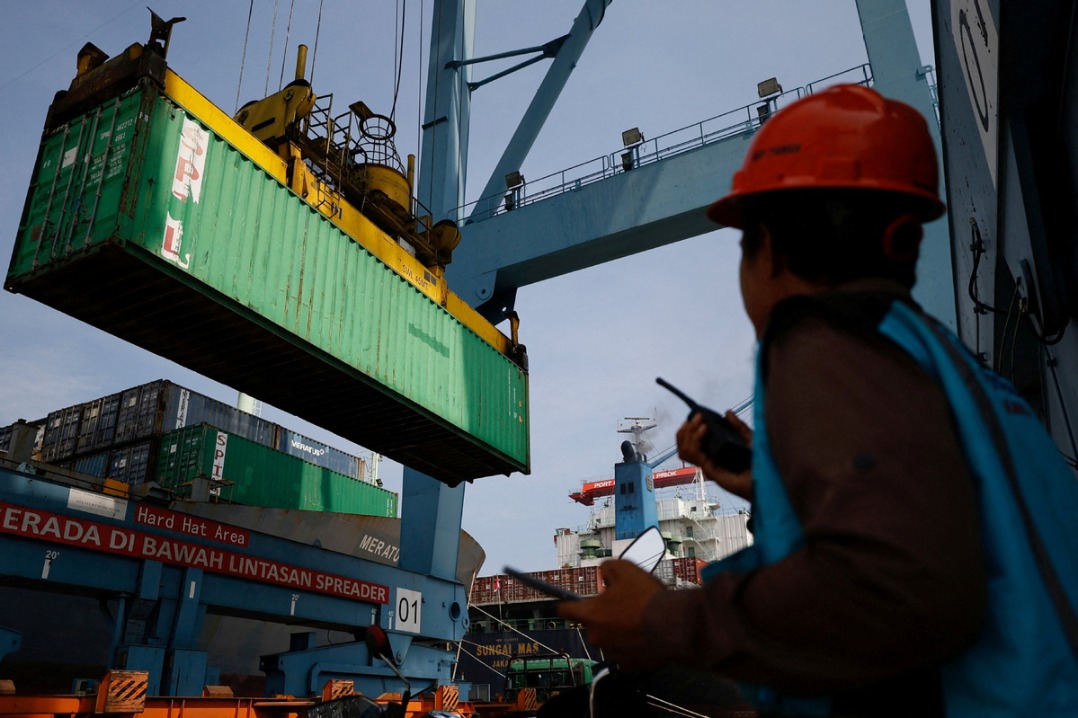With more external woes, smart macro moves key to sound 2022


Since the COVID-19 outbreak, development gaps between nations due to different levels of anti-COVID measures have exacerbated divergences in the global economy, generating even more risks facing the Chinese economy this year. In view of the external environment, there are three major challenges in this situation China now is confronting.
First, before the Russia-Ukraine conflict, the International Monetary Fund lowered its 2022 global economic growth forecast to 4.4 percent, down from 5.9 percent in 2021, and that for the United States to 4 percent from 5.6 percent. For the eurozone, the number was lowered to 3.9 percent from 5.2 percent last year. Yet now, with the adverse impact of the conflict, it may be revised down further. With Europe being one of China's major trading partners, and the US a key export market, all of the exterior uncertainties are potential woes that could hinder China's export momentum this year, making assessment of the geopolitical impact on foreign trade a must for Chinese regulators.
Second, the Chinese economy is currently facing downward pressure and is in a different cycle from the US economy, and the gap between the two giants may be larger. Even if the US economic growth rate has been revised down to 4.4 percent, it is still higher than the average of the past decade and well above the US trending growth rate.
In addition, the US Federal Reserve announced earlier this month a 25-basis-point interest rate hike, which may trigger adjustments in international capital flows, as well as changes in supply and demand in global financial markets.
However, as the 25 bps increase is relatively small and interest rates are still at a historically low level, the impact the US move may cause on global financial markets is expected to be limited. Meanwhile, the move was well predicted by the market as the Fed had been delivering related information. For China, what is worth noting is that the Fed's move is not a one-time action, but the beginning of a series of actions-a turning point in policy orientation.
For a long time, the Fed's monetary policy has been determined based upon the needs of the US itself, without consideration of spillover effects. At present, the US is facing severe inflationary pressure, and the inflation level will exceed the target range in the next two years, which is exactly the basis for the rate hike move. The market is also worried about a worsened situation due to inflation and economic stagnation.
Judging from the labor market, the unemployment rate in the US is expected to reach 3.5 percent by the end of this year-close to full employment-which may form a wretched cycle of higher wages and larger inflationary pressure.
What is happening in terms of both the current inflation and the employment situation is urging the US to take faster steps to abandon its easing policy. The interest rate hike by the Fed has led to dynamic changes in the interest rate gap between China and the US, which will have a certain impact on the renminbi exchange rate. As China's macroeconomic policy options are always made against the backdrop of global macro policy adjustments, it is a work that must be done effectively, with attention given to the impact of US monetary policy adjustments.
Third, how the Russia-Ukraine conflict evolves remains uncertain, which in fact had caused a direct impact on the turbulence in commodity markets and global financial market sentiment. In the past few years, Russia has successively reduced its holdings of US bonds in its foreign exchange reserves, and has achieved a certain degree of de-dollarization in the currency in which imported goods are denominated. Exported goods, however, are still mainly denominated in US dollars.
So, it's fair to say Russia is not fighting an unprepared war, and had prepared in terms of its economy and financial bearing. While direct effects brought by the Russia-Ukraine conflict are being witnessed in many sectors, various secondary disasters are also being seen one after another, among which are the financial and economic sanctions imposed on Russia by Western countries led by the US. But the sanctions are very different from those in the past. The latest sanctions have restricted the use of forex reserves held by Russia and excluded some Russian banks from the SWIFT system, which has dented relevant countries' confidence in the US dollar. On the bright side, it may be a new reform opportunity for the international currency system to promote de-dollarization and reserve diversification.
In the short term, the above three external factors pose more challenges to China's economy than opportunities, and should be dealt with in a proper and cautious manner. The two sessions this year set a target of 5.5 percent GDP growth, which is the upper limit of general market expectations, reflecting the government's priority in employment and resolve to provide a certain number of job opportunities for more than 10 million new college graduates. The target is also a hard nut that must be cracked to meet the requirements of the overall goals of the 14th Five-Year Plan (2021-25).
From the perspective of both internal pressure and the external environment faced by China's economic growth, the target can by no means be reached only through modest measures, but greater efforts are needed to achieve that goal. With the continuous slower growth seen in the third and fourth quarters, and a growth rate of 4 percent in the fourth quarter, the uptrend of the first quarter is under relatively heavy pressure, and it will be difficult to fundamentally reverse the trend of economic deceleration in growth. For the whole year, to achieve the 5.5 percent target requires the coordination and support from macro elements.
To this end, as has been highlighted in many meetings and forums, implementing long-term structural reforms has been well acknowledged to be key to achieving high-quality economic development in China. However, the implementation of relevant measures needs to reduce and control possible side effects and avoid unintended shocks to the financial sector. Therefore, structural reform policies should refine the process and strengthen process management and risk control.
First, the government should strengthen the management of relevant policy expectations. When functional departments introduce structural policies, including those targeting market-oriented reforms and production factors, they should conduct adequate deductions accordingly, fully consider the impact of industry-specific measures on the financial market and consider potential perspectives of the domestic market and the international market in terms of policy interpretation. Proper and understandable vocabulary should be used to ensure sufficient communication with market players.
Second, cooperation between relevant functional departments should be further strengthened. For instance, there is still ample room for further cooperation between online platform standardization and financial management departments.
Third, the continuous impact of the Russia-Ukraine conflict may lead to the concentrated release of global systemic risks, which will have a greater impact on financial markets. Plans should be formulated in advance for abnormal market fluctuations while strengthening risk management in the process of implementing structural policies so as to enhance policy implementation and make ensuing policies play their proper role.
The writer is chief economist with Bank of China (Hong Kong). The article is a translated version of an address by the writer to China Macroeconomy Forum, a Chinese think tank.
The views don't necessarily reflect those of China Daily.





































